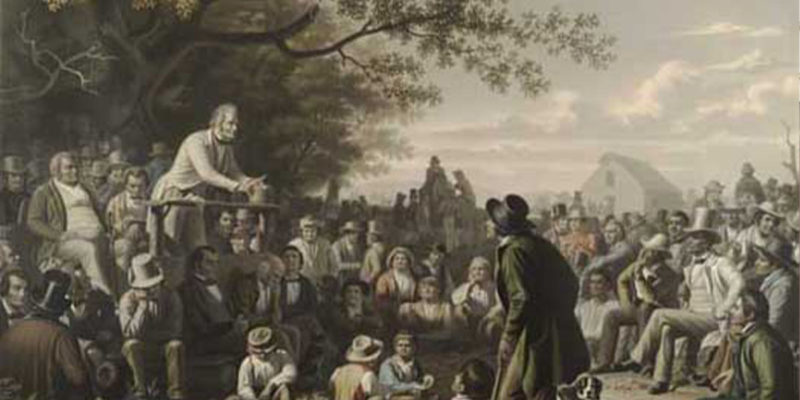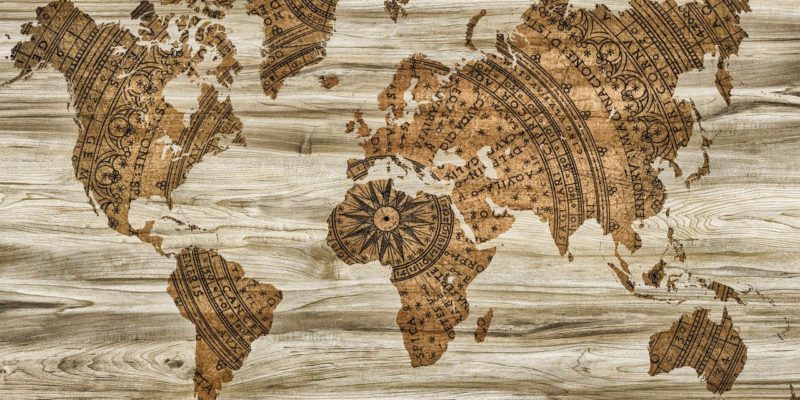W. B. Yeats’ poem “The Second Coming” has long captivated and bewildered readers with its mystical symbolism and imagery. These metaphors and motifs have invited debates between readers since the poem’s publication in 1921, yet focusing on the poem’s mysterious allusions can lead one to neglect the practical message and significance of its allusions. With this in mind, I would like to propose reading “The Second Coming” through a lens of “Christian eco-theology” as explained by Fr. Seán McDonagh in Pluriverse: A Post-Development Dictionary, concentrating on Yeats’s use of natural images.
Before diving into the poem itself, we must understand what Christian eco-theology is. McDonagh explains that this concept emerges from the close association between modern Catholic social teaching and industrialism. Twentieth-century popes and other Catholic observers noted “the negative social impacts of liberal capitalism” and therefore developed teachings which acknowledged that “industrialization was adding to the misery of the poor” and advocated a new evaluating framework for authentic human development (118). Beginning with Fr. Thomas Berry’s incorporation of the Jesuit mystic and scientists Pierre Teilhard de Chardin’s theory into viable theology of creation, Christian theology started to integrate ecology into its creed and pursue “a new way of living with the rest of the natural world” (118). This notion of “captur[ing] the proper place for humankind in the evolutionary story of the emerging universe, of the planet Earth and of all life on the planet” serves as the foundation of Christian eco-theology.
When we juxtapose this idea with Yeats’s “Second Coming,” we notice an intriguing commonality between the two. Yeats’s poem welcomes its reader with an opening line establishing a sense of rupture between humankind and nature: “Turning and turning in the widening gyre / The falcon cannot hear the falconer.” With such a connection severed, “[t]hings fall apart; the centre cannot hold.” In considering this line from the perspective of Christian eco-theology, one wonders whether the fact that “the centre cannot hold” implies a falsehood of humankind positioning themselves at the very center of the cosmos, a location that is not the “proper place” for us.” (118). Following the collapse of this system, either due to our detachment from the natural rhythms of “widening gyre” or through the arrogance of our self-centeredness, Yeats introduces the reader to images with more explicit religious connotations: “The blood-dimmed tide is loosed, and everywhere / The ceremony of innocence is drowned.” Undoubtedly, the blood-dimmed tide serves as an allusion to heavenly catastrophe, which corresponds to the prophecy in the Book of Revelation: “And the second let what was in his vessel come out into the sea; and it became blood as of a dead man; and every living thing in the sea came to an end” (Revelation 16:3). The biblical passage illustrates whose blood the tide sheds—it is the blood of all creatures, for the apocalypse is universal, and all natural beings live and die in cooperation with each other. Humankind is, in evolutionary essence, part of this natural Creation, while God is its Creator. Therefore, there exists a sacredness in all the creations of God, though such a sacredness has been long forgotten.
Yet do not human beings also possess the ability to create? If so, what do they create? The poem’s second stanza introduces the reader to the “vast image out of Spiritus Mundi”: “a waste of desert sand; A shape with lion body and the head of a man.” The desolate wasteland covered with sand evokes images of the aftermath of deforestation, overexploitation, and pollution. This image of the desert reminds the reader of the permanent violence that modern humankind commits to the biosystem through artificial activities. McDonagh observes a connection between liberation theology and “ecological issues such as climate change, extinction of species and poisoning of oceans and fresh water” (119). Liberation theology focuses on the socio-economic status of the oppressed, while eco-theology emphasizes that the earth is oppressed as well, drawing from Pope Francis’ encyclical letter Laudato si’ and its claim that “[t]he earth herself, burdened and laid waste, is among the most abandoned and maltreated of our poor” (“Encyclical Letter ‘Laudato Si’”). The specific image of “Spiritus Mundi,” a collective memory of time, is portrayed by Yeats as a compound Sphinx creature with both human and animal characteristics. Such a combination could, of course, lead to an interpretation that demonstrates the human-nature connection again. However, the creature as portrayed in its Greek mythological origins turns out to be a “demon of destruction and bad luck” that poses a life-threatening riddle to travelers to allow them passage (“Sphinx”). Intriguingly, the answer to that famously difficult riddle is exactly “human being.”
Is the Sphinx an artificial creation, a man-made figure? If we understand the Sphinx as a monster, is not that monster ultimately created by ourselves? It becomes a grotesque human creation that interrogates us with a question about ourselves, a question few people are able to provide a correct answer to. Few people, in other words, are able to recognize ourselves and our catastrophic ability to produce disasters. Yeats himself displays an ambivalent attitude when asked to answer such a question in his “On Being Asked for a War Poem,” his response to the Irish Revolution, in which he writes “I think it better that in times like these / A poet’s mouth be silent, for in truth / We have no gift to set a statesman right.” Humankind is able to give birth to poetry, or guns. Published in 1921, “The Second Coming” is Yeats’s response to the violence done to both humanity and the environment during the Revolution, which was fought from 1919 to 1921. Justin Stover examines the environmental degradation due to this revolution in his forthcoming book Enduring Ruin: Environmental Destruction during the Irish Revolution, which “incorporates the roles animals, earth, water, trees, weather, and man-made infrastructure played in directing and absorbing revolutionary violence.” The book came out in August 2023, over one hundred years after the end of the war and too late to reckon with the immediate destructive consequences. Our ignorance of ourselves and the traces we have left, as the story of the Sphinx reminds us, spans from antiquity to the present. Recognition of this fact often arrives too late under “this regime of technical ‘development’” (McDonagh 120). An eco-theological reading of “The Second Coming” causes us to see the indignation of the desert birds and the pitilessness of the sun as replies to the fact that “[h]uman technologies cause major damage to the fabric of life on Earth” (McDonagh 120).
Therefore, while Yeats’s poem may be read to highlights its author’s anticipation of the end of time, I suggest also focusing on the line, “Hardly are those words out,” which emphasizes that the image of desert land and the Sphinx precedes the arrival of the Second Coming. Certainly, the Second Coming may bring a message of refreshment and renewal, yet it should not be treated as an obliteration of what came before, of the evil that humankind has inflicted on itself and on the earth. “Surely the Second Coming is at hand,” yet prior to that comes Judgement Day, to ensure that justice is served for those irredeemable losses. Yeats indeed admonishes the reader in this way at the very end of the poem, as he depicts the Messiah, with an intimidating exclamation, as “what rough beast.” The Second Coming of Jesus, to Yeats, arrives in a form of a beast instead of a man, which seems to suggest that nature will have its revenge of nature on humankind. Such a (re)birth of Messiah should be expected, yet at the same time be revered with fear.
Works Cited
Francis. “Encyclical Letter ‘Laudato Si’ of the Holy Father Francis on Care for Our Common Home.” Climate Diplomacy, 18 June 2015, https://climate-diplomacy.org/magazine/environment/encyclical-letter-laudato-si-holy-father-francis-care-our-common-home.
“Justin Dolan Stover Publishes First Book ‘Enduring Ruin: Environmental Destruction during the Irish Revolution.’” Idaho State University, 9 Mar. 2023, https://www.isu.edu/news/2023-spring/justin-dolan-stover-publishes-first-book-enduring-ruin-environmental-destruction-during-the-irish-revolution.html.
McDonagh, Seán. “Christian Eco-Theology.” Pluriverse: A Post-Development Dictionary, edited by Ashish Kothari et al., Tulika Books and Authorsupfront, New Delhi, 2019, pp. 118–120.
“Sphinx.” Wikipedia, Wikimedia Foundation, 16 Mar. 2023, en.wikipedia.org/wiki/Sphinx. Accessed 21 Mar. 2023.
The Bible. Authorized King James Version, Oxford UP, 1998.
Yeats, William Butler. “On Being Asked for a War Poem.” Poetry Foundation, Poetry Foundation, https://www.poetryfoundation.org/poems/57313/on-being-asked-for-a-war-poem.
Yeats, William Butler. “The Second Coming by William Butler Yeats.” Poetry Foundation, Poetry Foundation, https://www.poetryfoundation.org/poems/43290/the-second-coming.




 Compass is an online journal that provides a space for the work of talented undergraduates who have original and well-articulated insights on important ideas and issues relating to American democracy understood in the broad contexts of political philosophy, history, literature, economics, and culture.
Compass is an online journal that provides a space for the work of talented undergraduates who have original and well-articulated insights on important ideas and issues relating to American democracy understood in the broad contexts of political philosophy, history, literature, economics, and culture.